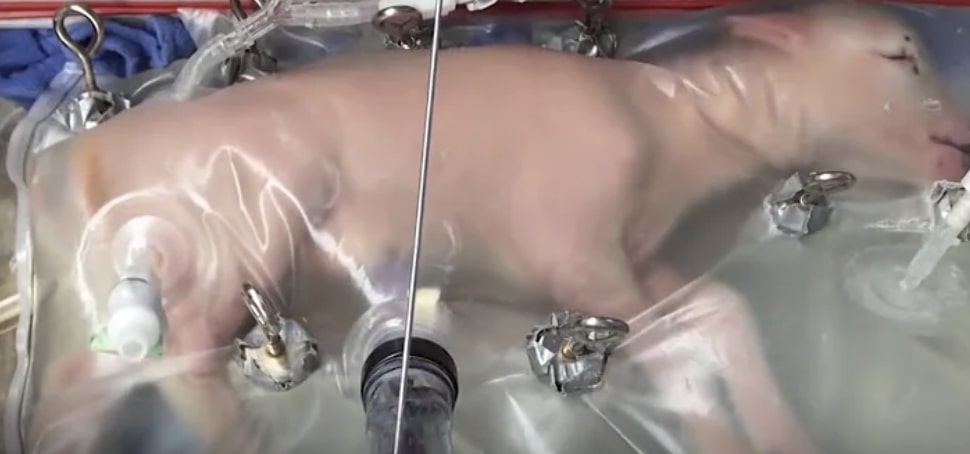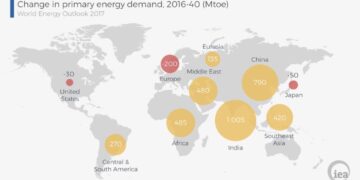Nextbigfuture reader, Scott Baker, has gathered excellent information about the state of artificial womb development. Scott did this in response to my articles describing the massive global depopulation crisis.
Scott has found videos and information about were tests over one year ago of biobags to help premature sheep. These are early forms of devices which could become artificial wombs. We are at the animal testing stage now. They should be able to help extremely premature babies that are too under developed incubators.
Here is why, I do not think artificial wombs can solve the depopulation crisis:
1. We do not know we can bridge the gap between 3-4 week embryos in test tube babies through to premature babies at 24 weeks or 20 weeks. It is not just the life support. There are hormones interaction from the mother or biological womb and the baby.
2. There are costs even if it works. An artificial womb is basically an in vitro fertilization and a 270 day incubator procedure. Below, I show how very optimistic assumption get us to a cost of about $300,000 per pregnancy.
3. This procedure might need to scale to 100 million babies per year in order to make up for the global shortfall of babies. This would be $30 trillion per year at scale.
4. Gestational Surrogacy has existed for decades. There are up to 100,000 per year surrogacy births globally but the total numbers might be about 20,000 per year or less. It is a fraction of the IVF numbers as Gestational Surrogacy is IVF and also having another women carry and deliver the baby The surrogate women gets about $15,000 to 150,000. Surrogacy is expected to grow to perhaps 1 million birth per year by 2032 a $129 billion global industry.
5. Gestational Surrogacy has been proven to work for tens of thousands of babies. There are no technical, scientific and medical questions that another women’s womb can deliver an IVF baby. It is far cheaper than neonatal care. This is a capability and option that be scaled up by low birth countries (Japan, South Korea, China, Italy, Spain etc… today). Programs for egg harvesting from young women for more successful future IVF, and state supported IVF and state supported surrogacy could increase births by 25-50%.
Scott projects that in 5-10 years, they will be in limited commercial use of artificial wombs in countries with low fertility. However, IVF and surrogacy does everything that a perfected commercial artificial womb does.
He points out there are only about 20 weeks in human development that needs to be filled in with artificial wombs. We can already grow an embryo in a Petri dish for up to a month and incubators work more-or-less well from 6.5 months forward; the incubators could be replaced by more reliable artificial wombs if they became available at the earlier stages.
Scott will have to explain to me why we should wait for this technology versus scaling up IVF and surrogacy and just increasing the financial incentives to couples.

IVF is Used for 2% of US Births
IVF (Invitro fertilization) is the test tube baby process. It was first used successfully in 1978. After 46 years there have been about 12 million IVF births and 2% of US birth use this process every year. This is about 75,000 out of 3.6 million births. The world is nearing 1 million IVF births per year.
There are 70 million couples who have fertility problems. There are ten times as many couples who want babies but are having trouble than the number of IVF births. The world is not meeting the demand for assisted pregnancies with the technological product and services (IVF and egg harvesting, IVF and surrogacy) that can solve that problem.
IVF costs $10k-30k. It can be cheaper in China.
A standard incubator for a newborn intensive care unit can cost between $1,500 and $35,000.
In the United States, the average cost of a neonatal intensive care unit (NICU) stay is around $3,000 per day, but can range from $3,000 to $20,000 per day.
Cost of Artificial Wombs and Scaling
The artificial womb would have more cost than a standard incubator. Let’s simplify and assume 9 months of neonatal care at even less cost than intensive care of $1000 per day. This could be like $10k for the IVF to start and then $1K per day for the womb. This would be $270k for the procedure once it is a relatively mature process.
If there are humanoid robots, the cost might be reduced to $30-50k.
If we only have half of the number of needed babies to sustain the global population of 8 billion in 2060 or so. We are at 75 million per year instead of 150 million.
This would mean scaling up IVF by 5000%, mastering the development of the new artificial womb technology, having the artificial womb work not just on premature animals but on humans, extend from 20-28 week operation to 0-36 weeks, mass produce to about 100 million units.
This is also mean going to scale with limited testing and observation of the development of people who went through the process. What the long term development of the artificial womb children vs natural womb children. The artificial womb mothers would not activate lactation. There are mothers now who only choose formula. Baby formula for a year is $760-3000.
IF there is no massive cost reduction then the $100,000-200,000 cost per pregnancy is comparable to the levels of increased financial incentives that I estimate are needed to encourage women, surrogates and families to have the needed children.
Scott thinks that the artificial womb will begin impacting fertility rates in 30 years. IVF got to 2% fertility improvement after 45 years.
This means some minimal viable products around 2060 and possibly some impact in 2100.
China’s population could drop from 1.4 billion to 1 billion by 2050-2060. Japan’s population will have dropped below 100 million by 2050. China’s population could drop to 400 million by 2100.
IF the solution is to scale $270k per pregnancy solutions in 2100, then financially we should straight up offer that cash now to encourage couples to have more natural babies. Also, Surrogacy at scale can be performed at $15k-150k.
Antiaging Mainly Matters if the Aging Reversal Maintains Longer Fertility and the Fertility is Used
If Antiaging only extends lives to 200 years long but the duration of fertility is not impacted then it does not address the core problem of depopulation.

Brian Wang is a Futurist Thought Leader and a popular Science blogger with 1 million readers per month. His blog Nextbigfuture.com is ranked #1 Science News Blog. It covers many disruptive technology and trends including Space, Robotics, Artificial Intelligence, Medicine, Anti-aging Biotechnology, and Nanotechnology.
Known for identifying cutting edge technologies, he is currently a Co-Founder of a startup and fundraiser for high potential early-stage companies. He is the Head of Research for Allocations for deep technology investments and an Angel Investor at Space Angels.
A frequent speaker at corporations, he has been a TEDx speaker, a Singularity University speaker and guest at numerous interviews for radio and podcasts. He is open to public speaking and advising engagements.
>>> Read full article>>>
Copyright for syndicated content belongs to the linked Source : Next Big Future – https://www.nextbigfuture.com/2024/03/would-artificial-wombs-solve-the-depopulation-crisis.html














![[News] China Makes Breakthrough in Chip Technology, Paving the Way for Lithography Advancements – TrendForce](https://earth-news.info/wp-content/uploads/2025/11/324664-news-china-makes-breakthrough-in-chip-technology-paving-the-way-for-lithography-advancements-trendforce-360x180.jpg)
















